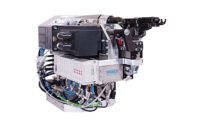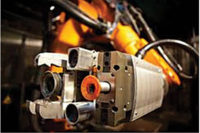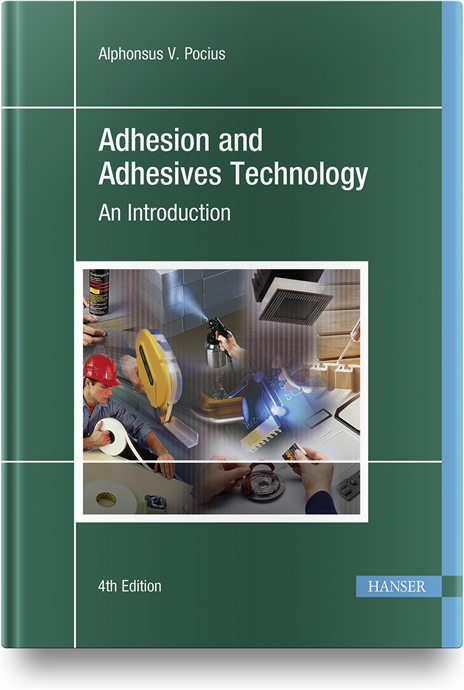Static electricity can do much more than levitate a person’s hair with the help of a charged balloon. This scientific phenomenon, technically known as electroadhesion, can also enable a robotic gripper to easily handle material as fragile as an egg and as flimsy as soft fabric.
In 2015, Sunnyvale, CA-based Grabit Inc. developed such a gripper for its Stackit auto-layering robot system to help Nike significantly increase productivity. The gripper features a flat pad of electrodes that generate positive and negative charges, thereby creating an electric field that adheres to surfaces as diverse as leather, mesh and composite fibers.
The gripper is mounted to a Toshiba Machine SCARA robot, enabling it to stack up to 40 pieces of material for a shoe upper—the flexible part that sits on top of the foot—in only 50 to 75 seconds and manufacture 300 to 600 pairs of gym shoes in an eight-hour shift. Arranging the layers manually can take up to 20 minutes, notes Greg Miller, president and CEO of Grabit.
Harsha Prahlad, Ph.D., chief technology and products officer at Grabit, discovered the manufacturing capability of electroroadhesion in early 2013 while working at SRI International, a nonprofit research organization. He founded Grabit later that year, with financial backing from Nike.
While developing the Stackit system, Prahlad’s main challenge was finding the right robot to use with the gripper. He needed a long-reach robot that always performed precise material handling. Because the gripper is so large, the robot also needed to withstand a big moment of inertia and rotate the gripper accurately.
A handful of standard robots were extensively tested, according to Prahlad, but none of them moved quick enough to meet the supplier’s required cycle times of 20 times faster than manual assembly. In addition, these robots were too large and prevented the use of Grabit’s gripper control system.
Prahlad and his team then met with TM Robotics Inc. (TMR), Toshiba Machine’s American and European distributor. TMR had Prahlad adjust and test an off-the-shelf robot, but the gripper inertia, combined with the time required for the gripper to rotate and the robot to settle and stabilize, prevented the prototype Grabit system from achieving the required cycle times. To do so, would have required building and installing a special transmission.
Prahlad and his team then looked closely at the supplier’s THL1000 SCARA robot, which has an allowable moment of inertia of 0.2 kilogram per meter and X-Y repeatability of 0.01 millimeter. It features four controlled axes, absolute encoders and a 1,000-millimeter arm length.
The standard model offers a maximum payload of 10 kilograms against a total mass of 37 kilograms, and a cycle time of 0.48 second with a load of 2 kilograms. For the Stackit machine, however, Grabit had TMR provide a robot with a custom gear ratio for enhanced payload capability.
Other models in the THL Series include the THL500, THL600 and THL700 with arm lengths of 500, 600 and 700 millimeters, respectively. The arm is made of lightweight, die-cast aluminum and has a payload capacity of 10 kilograms. Cycle times (with a 2-kilogram load) are 0.45 second for the THL500 and THL600, and 0.5 second for the THL700. All robots have a Z-axis rotation of 360 degrees.
For more information on SCARA robots, call 847-709-7308 or visit https://grabitinc.com.






